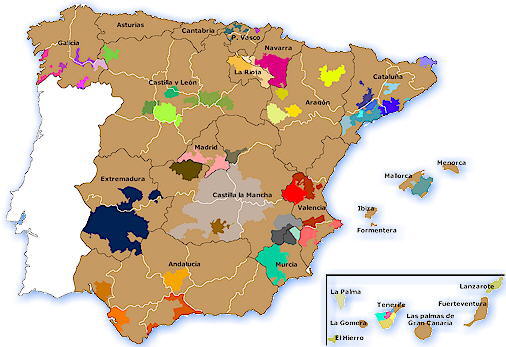Esta es la pregunta que suelen hacernos en hostelería cuando pedimos un vino tinto. Sin embargo, ¡en España existen más de 60 Denominaciones de Origen! La mayoría completamente desconocidas para el consumidor medio. Cierto es que las grandes, Ribera y Rioja, como en blancos, Rueda o Rías Baixas, son las de las más antiguas y, por tanto, han tenido más tiempo para hacerse un nombre y lograr que los consumidores las vean como marcas de calidad.
Pero no podemos negar la evidencia: los vinos de calidad no sólo existen en la Ribera del Duero o en Rioja. Podemos beber grandes caldos del Tierra del Vino de Zamora, Valdeorras, Jumilla, Utiel-Requena, Ribera Sacra, Abona, y muchas otras. Entonces, ¿por qué no encontramos más referencias en la mayoría de bares y restaurantes? La respuesta es clara, el consumidor va a lo seguro, tiene miedo de arriesgarse y, ante todo, reina un profundo desconocimiento de la gran riqueza que posee España en lo que a variedad de vinos se refiere.
Las Denominaciones de Origen hacen referencia a vinos provenientes de una zona geográfica determinada. La vid es particularmente susceptible de ser diferenciada en zonas distintas, ya que las distintas condiciones de suelo, clima, orografía, prácticas, tanto del viticultor como del elaborador del vino o, incluso, variedades autóctonas de las distintas regiones, hacen posible que podamos obtener vinos completamente distintos en sus cualidades organolépticas y estructura. Todos estos factores hacen de España uno de los países más ricos, en términos vitivinícolas, del mundo.
En conclusión, la pregunta que debemos hacernos es si las “no tan conocidas” D.O.s están haciendo lo necesario para que esta situación cambie. Desde luego, las grandes sí que están moviéndose para mantenerse en la cima y no perder cuota de mercado, con recurrentes campañas de publicidad. Otras como Toro, Vinos de Madrid, Priorat, han dado algunos pasos en el buen camino y, poco a poco, se van haciendo un nombre. Pero dados los recursos existentes hoy en día, con las redes sociales y con internet en general, no se explica esta falta de actuación de las menos conocidas. Los Consejos Reguladores tienen los medios para acceder a un gran público a un click y a un coste menor que hace unos años. No pueden dejar pasar más tiempo sin acceder a la parte del pastel que legítimamente les corresponde, dado el gran esfuerzo que han hecho enólogos y bodegas en obtener una calidad excepcional.
Fuente de foto: granseleccion.com
Este post en inglés: Beyond Rioja or Ribera?
This is always what we are asked when we order a glass of red wine in a bar or restaurant. However, there are more than 60 Appellations of Origin in Spain! Most of which are a complete unknown to the average consumer. Yes, it is true that Ribera and Rioja, or in white wines , Rías Baixas and Rueda, are among the oldest Appellations and therefore have had more time to build a reputation and ensure that consumers see them as quality trademarks.
Yet, we cannot deny the evidence: quality wines exist not only in the Ribera del Duero and Rioja. We can drink great wines from the Tierra del Vino de Zamora, Valdeorras, Jumilla, utiel-Requena, Ribera Sacra, paid, and many others. Then, why is it impossible to find more wine-region references in the majority of bars and restaurants? The answer is clear, consumers prefer to be safe in the decisions, they are afraid of risk, and first and foremost, There is a profound ignorance of the wealth that Spain has in variety of wines.
Appellations of Origin refer to wines from a specific geographical area. The vine is particularly susceptible to be differentiated in various areas, since the different conditions of soil, climate, orography, practices from both, the wine grower and manufacturers of wine, or indeed, landraces in the different regions. All these factors make possible that we get completely different wines, particularly concerning its organoleptic properties and structure. This is why make Spain is one of the richest countries, in wine terms, of the world.
In conclusion, the question we must ask to ourselves is whether the «not well-known» Appellations of Origin are doing what is necessary to ensure that this situation changes. What is clear is that “the big four” Appellations in Spain are taking the steps to stay on top and not to lose market share with huge advertising campaigns. Others, such as Toro, Vinos de Madrid, or Priorat have made some improvements towards the right direction and little by little are achieving a quality trademark. But given the existing resources today, with social networks and the internet in general, this lack of performance of the least known cannot be explained. Regulator Councils have the means to reach a large audience in a click and at a lower cost than a few years ago. They may not waste more time without having access to the part of the cake that they legitimately should own. This is going to be a great challenge but the benefits for them will be huge, given the great effort made by winemakers and wineries in the last years to achieve an exceptional quality.
This post in Spanish: ¿Más allá del Ribera o Rioja?
This image comes from: granseleccion.com
